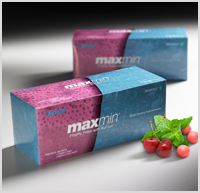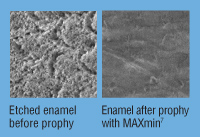MAXmin Value. Minimum Splatter. And MAXmin Minerals.
Studies show that saliva containing fluoride, calcium and phosphate can aid the remineralization process. 1,2,3,4 Plus, it just makes sense to put back the building blocks removed during a prophy. But all calcium phosphate paste are not alike: Sweetened with Xylitol, MAXmin 5,6 doesn’t splatter… rinses better (no chalking residue left on the oral mucosa) … and costs less than the other leading brands.
So if your contemplating a move to a calcium phosphate paste, order MAXmin Prophy Paste with NuFluor, our unique fluoride, calcium and phosphate chemistry designed specifically for prophy paste. It’s 100% guaranteed. Order MAXmin today or call us at 1-800-474-8681 and we’ll immediately ship your order in your dealer’s name.
1 Barnes CM, The Evolution of Prophy Paste. Dimensions Dent Hyg 2011; 9(3): 50-52. 2 Chow, L Wefel JS. The Dynamics of De- Remineralization. Dimensions Dent Hyg 2009:7 (2) 42-46. 3 Garcia-Godoy F, Hicks MJ. Maintaining the integrity of enamel surface: The role of dental biofilm, saliva and preventive agents in demineralization and remineralization. J AM Dent Assoc 2008:139;25S-35S. 4 Featherstone J. Delivery challenges for fluoride, chlorhexidine and xylitol. BMC Oral Health 2006 (Suppl 1): S8 1-5. 5 Data on file. 6 The formula for MAXmin is patent-pending. 7 University of Maryland data.


- How are dental prophylaxis pastes regulated and classified in the USA?
- Dental prophylaxis pastes are regulated by the FDA Center for Devices and Radiological Health (CDRH) and are classified as Class I Medical Devices.
- What product claims are allowable under this regulatory classification?
- Dental prophylaxis pastes are indicated for cleaning and polishing teeth as part of a professionally administered prophylaxis treatment as described in the classification regulation for "oral cavity abrasive polishing agents" in the Code of Federal Regulations 21 CFR 872.6030. Identification. An oral cavity abrasive polishing agent is a device in paste or powder form that contains an abrasive material, such as silica pumice, intended to remove debris from the teeth. The abrasive polish is applied to the teeth by a handpiece attachment (prophylaxis cup). Some prophylaxis pastes have also been cleared to include the indication for use "immediate relief of tooth sensitivity, pre and post -scaling and root planning."
- What are the regulatory requirement for dental prophylaxis products to be able to make therapeutic claims?
- While the addition of anti-caries agents makes logical sense in dental prophylaxis, large scale, multi-center clinical studies are required to determine the safety and efficacy of prophylaxis paste containing these therapeutic additives. Clinical studies are expensive and in small professional markets, the payback from such studies would be cost prohibitive. Additionally, the wide spread use of fluoride in drinking water, OTC and Rx oral care products greatly reduces the likelihood of a semi-annual application of prophylaxis paste providing any incremental caries prevention benefit for patients. As a result prophylaxis paste manufacturers have not conducted anti-caries studies to support any therapeutic claims platform.
- If prophy paste is not an effective “remin” product, what type of product(s) would be effective?
- Prescription strength fluoride containing products (5,000 ppm or greater ) used on a more frequent basis have been shown to remineralize tooth surfaces. Short term remineralization is achieved via a product regime which includes twice daily use of a fluoride containing toothpaste and fluoride containing oral rinses supplemented by in-office treatment with fluoride containing gels, foams and/or varnish application. The treatment protocol must follow the ADA recommended usage.
- If these added derivative prophylaxis pastes haven’t been clinically proven, then why are so many end users interested in Calcium and Phosphate containing products?
- Teeth need calcium, phosphate and fluoride. Fluoride ions bond easily with calcium ions always present on tooth surfaces and in saliva. Saliva is the mouth's primary defense against tooth decay. Research has proven that fluoride works to prevent tooth decay by boosting the ability of saliva to return lost minerals to tooth enamel before cavities can develop. Saliva enhances protection of enamel by providing high levels of calcium and phosphate ions at the tooth surface. The best explanation of how fluoride, calcium and phosphate work is that they aid / enhance the natural properties of saliva.
- MAXmin Prophy Paste contains patented NuFluor. What is NuFluor?
- MAXmin Prophylaxis Paste is a proprietary patented formula developed by Preventch R&D. Unlike other prophylaxis paste brands that simply added a compound designed for use in consumer product applications into their paste formulations, our R&D started from scratch reviewing a comprehensive list of paste ingredients, ingredient/ formulation interactions, the manufacturing process and… the result is MAXmin Prophylaxis Paste with NuFluor, our unique Fluoride, Calcium and Phosphate chemistry designed specifically for prophy paste. This "starting from scratch" development process not only gives MAXmin it's unique fluoride, calcium and phosphate chemistry but also delivers to the end user a paste that goes on easy without splatter, is tough on stains, and unlike other mineral additive paste, MAXmin flash rinses to a clean finish - no chalky white residue left on the oral mucosa.







 Samples
Samples









